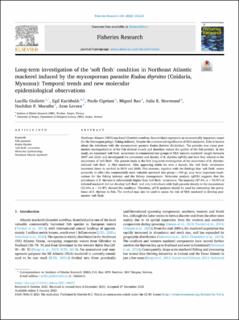| dc.contributor.author | Giulietti, Lucilla | |
| dc.contributor.author | Karlsbakk, Egil Erlingsson | |
| dc.contributor.author | Cipriani, Paolo | |
| dc.contributor.author | Bao Dominguez, Miguel | |
| dc.contributor.author | Storesund, Julia Endresen | |
| dc.contributor.author | Marathe, Nachiket | |
| dc.contributor.author | Levsen, Arne | |
| dc.date.accessioned | 2022-06-22T13:14:27Z | |
| dc.date.available | 2022-06-22T13:14:27Z | |
| dc.date.created | 2022-01-24T10:00:01Z | |
| dc.date.issued | 2022 | |
| dc.identifier.issn | 0165-7836 | |
| dc.identifier.uri | https://hdl.handle.net/11250/3000081 | |
| dc.description.abstract | Northeast Atlantic (NEA) mackerel (Scomber scombrus, Scombridae) represents an economically important target for the Norwegian pelagic fishing industry. Despite the commercial significance of NEA mackerel, little is known about the infections with the myxosporean parasite Kudoa thyrsites (Kudoidae). The parasite may cause post-mortem myoliquefaction of the fish skeletal muscle and therefore reduce the quality of the fish product. In this study, we examined ‘soft flesh’ occurrence in commercial size groups of NEA ‘autumn mackerel’ caught between 2007 and 2020, and investigated the prevalence and density of K. thyrsites (qPCR) and how they related to the occurrence of ‘soft flesh’. The present study is the first long-term investigation of the occurrence of K. thyrsites-induced ‘soft flesh’ in NEA mackerel. After appearing stable for over a decade, the ‘soft flesh’ occurrence increased three- to six-fold in 2019 and 2020. This increase, together with the findings that ‘soft flesh’ seems primarily to affect the commercially most valuable mackerel size group (>400 g), may have important implications for the fishing industry and the fishery management. Molecular analysis (qPCR) suggests that the prevalence of K. thyrsites is substantially higher than ‘soft flesh’ occurrence. The majority (87.4%, n = 76/87) of infected mackerel did not develop ‘soft flesh’ and only individuals with high parasite density in the musculature (12.6%, n = 11/87) showed the condition. Therefore, qPCR analyses should be used for estimating the prevalence of K. thyrsites in fish. The method may also be used to assess the risk of NEA mackerel to develop post-mortem ‘soft flesh’. | en_US |
| dc.language.iso | eng | en_US |
| dc.title | Long-term investigation of the ‘soft flesh’ condition in Northeast Atlantic mackerel induced by the myxosporean parasite Kudoa thyrsites (Cnidaria, Myxozoa): Temporal trends and new molecular epidemiological observations | en_US |
| dc.title.alternative | Long-term investigation of the ‘soft flesh’ condition in Northeast Atlantic mackerel induced by the myxosporean parasite Kudoa thyrsites (Cnidaria, Myxozoa): Temporal trends and new molecular epidemiological observations | en_US |
| dc.type | Peer reviewed | en_US |
| dc.type | Journal article | en_US |
| dc.description.version | publishedVersion | en_US |
| dc.source.journal | Fisheries Research | en_US |
| dc.identifier.doi | 10.1016/j.fishres.2021.106221 | |
| dc.identifier.cristin | 1988283 | |
| cristin.ispublished | true | |
| cristin.fulltext | original | |
| cristin.qualitycode | 1 | |
